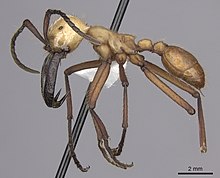Eciton hamatum is a species of army ant in the subfamily Dorylinae; it is found from Mexico to central Brazil and Bolivia. The species differs from Eciton burchellii, in that it does not fan out into the underbrush when foraging. Rather, it forages in columns, often in trees and preying exclusively on the larvae of other social insects. Its prey are often broods of vespid wasps and ants of genera Dolichoderus and Camponotus, suggesting that E. hamatum is mainly an arboreal forager.[1]
| Eciton hamatum | |
|---|---|

| |
| Scientific classification | |
| Domain: | Eukaryota |
| Kingdom: | Animalia |
| Phylum: | Arthropoda |
| Class: | Insecta |
| Order: | Hymenoptera |
| Family: | Formicidae |
| Genus: | Eciton |
| Species: | E. hamatum
|
| Binomial name | |
| Eciton hamatum (Fabricius, 1782)
| |
They are known to make living bridges with their bodies over small gaps.[2][3]
References
edit- ^ Longino, John T. (16 July 2005). "Formicidae: Eciton hamatum". The Evergreen State College. Archived from the original on 6 March 2007. Retrieved 9 February 2007.
- ^ Hogue, Charles Leonard (1972). The armies of the ant. p. 83. ISBN 0529045508.
- ^ Army Ant Bridge. YouTube (2015-11-24). Retrieved on 2018-05-09.
External links
edit- Media related to Eciton hamatum at Wikimedia Commons
- The Finding of the Queen of the Army Ant Eciton Hamatum Fabricius